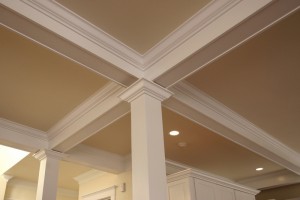Crown molding can help add a touch of class to any building, but are you familiar with the available material options? Let’s review the 4 crown molding materials. And see what might be right for you.
Crown Molding Materials
When you hear that crown molding has a type, it is referring to the material. The most common types of crown molding are wood, polyurethane, plaster and medium-density fiberboard (also known as MDF).
Wood Crown Molding
Wood is the most popular choice for crown molding. Part of its popularity is because there is a large range of woof species to work with, and fans of crown molding love the opportunity to choose between mahogany, oak and pine. Wood molding also has the option of being stained, veneered, painted or clear-coated. You may be familiar with the fact that hardwood floors can shrink and warp due to changes in temperature, and wood crown molding can face similar issues. A professional contractor will walk you through what to expect.
Polyurethane Crown Molding
Polyurethane is a good choice for homeowners who live in a climate with extreme changes in temperature or excessively hot or cold seasons. Polyurethane will not warp, expand or crack, and this type of molding will not stretch or attract bug infestations. This molding is only available as a painted option, however, and it can dent fairly easily.
Plaster Crown Molding
Plaster molding offers a unique style as it is custom-made, but that also means you want to hire a professional contractor to install it properly. Plaster crown molding can accentuate any room and offers many beautiful designs, but it is pricey because it is customized for a specific room. If you have the budget, though, this is a great way to add value.
Medium-Density Fiberboard (MDF)
If you like the look of wood but are afraid that your crown molding will suffer from shrinking and expanding, then MDF is the material you have been waiting for! This material uses a composite of resin and sawdust fibers, and it is available in a wide range of profiles. You can have it topped off with wood veneer to create a finish that looks like wood, and you can also have it as a painted trim. While it can still face issues like wood, it is less susceptible to shrinking, expanding and cracking.
This may seem very daunting, but the right contractor can help you make the best decision for you.
About Mahogany, Inc.
Mahogany, Inc. is a general contractor specializing in quality construction for projects across a wide range of industries. Located in southwest Baltimore, we employ 100 persons, and are one of the largest minority owned businesses in the state of Maryland. Make sure to check back with our blog every week for the latest industry related information. For more information, you can contact us at 410.727.0334, or email us. We look forward to hearing from you!

